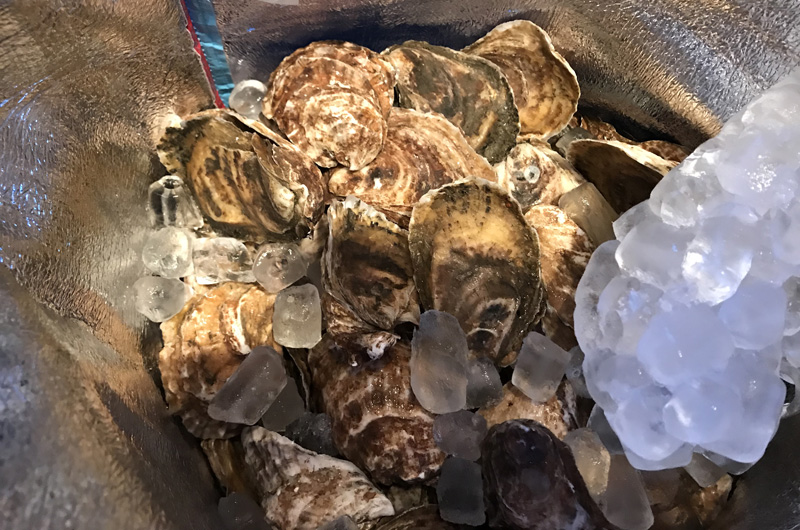In the late 1990s, as the commercial fishery was struggling and waterfront jobs seemed imperiled, about 15 Vineyard fishermen attended a training program on oyster farming, which was billed as a new way to make a living from the ocean.
Nearly 20 years later oyster farming is no longer a promising trend but a vibrant reality and a million-dollar industry on the Vineyard, five members of the Island aquaculture community told a gathering at the Gazette newsroom Tuesday.
Twelve oyster farms are thriving on Katama Bay, along with a handful of oyster farms in Menemsha Pond and another farm off Eastville in Oak Bluffs, the first open-water farm in the state. The oyster industry brings in nearly $2 million on the Island.
Rick Karney, executive director emeritus of the Martha’s Vineyard Shellfish Group, said he’s seen the industry grow since he came to the Island in 1973, back when aquaculture was futuristic.
“It’s the evolution of the shellfish industry,” he said to an audience at the Gazette as part of the paper’s off-season Tuesdays in the Newsroom series. “We’re evolving again from a wild fishery to still food production, in a different way that’s not damaging to the environment.”
Oyster farming remains a family industry rooted in traditions of working on the water, according to Ryan Smith, who has owned and operated Signature Oysters out of Katama Bay since 2005. He grew up on Vineyard waters, he said, as the son of fisherman Joe Smith. After he graduated from UMass Dartmouth in 2005, he started oyster farming on Katama Bay, where Edgartown allowed oyster farms early in the 2000s. Soon afterward his father left the wild fishery to join his son in aquaculture.
Oyster farms offer a more regular schedule and guaranteed catch than fishing, Joe Smith said, but the industries are otherwise similar. “I’ve seen some pretty impressive sets of wild fish out there, fish, scallops, whatever,” he said. “It’s pretty much the same way with growing them by yourself, except that you know they’re there.”
“It’s like having a big garden in the water,” Ryan Smith said. “If you neglect your plants you aren’t going to get any tomatoes. It’s the same thing. Just a lot of work.”
Oyster farmers tend to their crops year-round, including selling full-grown oysters and tumbling oysters so they don’t grow into each other (oysters naturally want to grow together to form a reef) and to remove any growths from the shells. In June oyster seed arrives, with each baby oyster roughly the size of a grain of sand. The oyster seed grows in boxes with screened tops and bottoms called upwellers, which are fed by the tide and allow the tiny oysters to filter feed and grow. They double in size within a week, Ryan Smith said, and by August they are the size of a nickel. It takes about two years for an oyster to reach market size.
While tending to the baby oysters the farmers continue to take care of last year’s babies, now much bigger but still too small to sell, while also harvesting full-grown oysters for market and following strict protocols about how the oysters are handled and chilled.
Vineyard oysters, often eaten raw on the half-shell, have become a specialty enjoyed at restaurants on the Vineyard and far beyond.
Beyond offering year-round, full-time jobs on the Vineyard, oyster farming is sustainable, according to Dan Martino, who started Cottage City Oysters in 2014 in the open water off Eastville Beach in Oak Bluffs with his brother, Greg.
“We don’t have to feed them,” Dan Martino said. “They are cleaning the water . . . it’s the most sustainable kind of protein farming on the planet.”
The Martino brothers faced permitting challenges and a lawsuit from concerned abutters as they tried to open their farm. Today they are thriving and recently became the first in the state to start growing kelp.
Greg Martino said the success of the Katama Bay farms led the way for Cottage City.
“Katama Bay allowed the town to grasp that something could be successful,” he said. “I think Katama Bay is really the shining example that everyone can point to and say yes, it can work.”
All five men pointed to one early oyster farmer as a mentor who led the way for the industry on the Island: Jack Blake, or St. Jack, according to Mr. Karney.
Mr. Blake mentored other oyster farmers and developed equipment and methods now used widely by other aquaculturists, including the upweller design used by most oyster farms on the Island to help the baby oysters grow.
“He’s a really remarkable fella, really inventive,” Mr. Karney said. “Jack...could have kept it all secret. We wouldn’t have seen 12 farms.”
He added: “we really have Jack to thank for not only being really open with this technology but also mentoring people.”
That includes the Smiths and the Martinos.
“He was my mentor,” Ryan Smith said. “He would say, ‘why are you doing this, you should be doing that.’”
There is room for more aquaculture on the Island, all agreed, and said they hoped to see towns continue to invest in the industry.
“This is the future of Island jobs, Island families, if we want to be a fishing community,” Dan Martino said.
The demand for fresh Vineyard oysters is also there. The evening concluded with Ryan Smith wielding a shucking knife along with his wife, Julia, serving freshly-harvested Signature Oysters to eager tasters.











Comments
Comment policy »